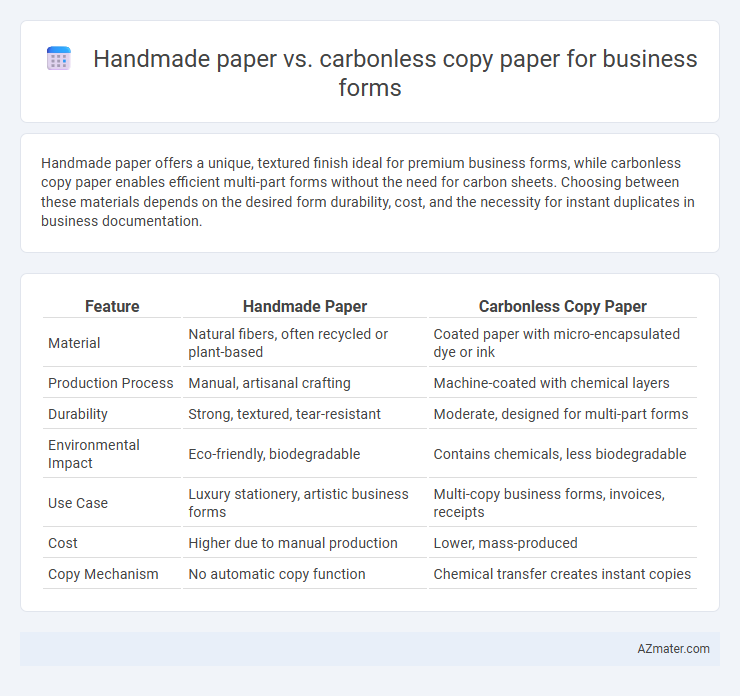Handmade paper offers a unique, textured finish ideal for premium business forms, while carbonless copy paper enables efficient multi-part forms without the need for carbon sheets. Choosing between these materials depends on the desired form durability, cost, and the necessity for instant duplicates in business documentation.
Table of Comparison
| Feature | Handmade Paper | Carbonless Copy Paper |
|---|---|---|
| Material | Natural fibers, often recycled or plant-based | Coated paper with micro-encapsulated dye or ink |
| Production Process | Manual, artisanal crafting | Machine-coated with chemical layers |
| Durability | Strong, textured, tear-resistant | Moderate, designed for multi-part forms |
| Environmental Impact | Eco-friendly, biodegradable | Contains chemicals, less biodegradable |
| Use Case | Luxury stationery, artistic business forms | Multi-copy business forms, invoices, receipts |
| Cost | Higher due to manual production | Lower, mass-produced |
| Copy Mechanism | No automatic copy function | Chemical transfer creates instant copies |
Overview: Handmade Paper vs Carbonless Copy Paper
Handmade paper offers a unique texture and artisanal quality ideal for premium business forms, enhancing brand image through its eco-friendly production and distinctive appearance. Carbonless copy paper (NCR paper) provides a functional solution for multi-part business forms, enabling instant duplicate copies without the need for carbon sheets, streamlining transaction efficiency. Choosing between handmade paper and carbonless copy paper depends on the balance between aesthetic appeal and practical duplication needs in business documentation.
Material Composition and Manufacturing Processes
Handmade paper is crafted from natural fibers such as cotton or recycled materials, utilizing traditional techniques that involve manual pulping and sheet formation, resulting in a textured, durable product suited for premium business forms. Carbonless copy paper consists of multiple layers coated with micro-encapsulated dye and reactive clay, produced through sophisticated chemical processes and coating technologies designed to transfer writing without carbon sheets. The distinct material compositions and manufacturing methods directly impact the tactile quality, environmental footprint, and functional purpose of each paper type in business form applications.
Environmental Impact and Sustainability
Handmade paper, produced using traditional methods with natural fibers, offers a biodegradable and compostable alternative to carbonless copy paper, which often contains chemical coatings that complicate recycling and contribute to environmental pollution. Businesses seeking sustainable forms benefit from handmade paper's lower carbon footprint and reduced reliance on synthetic chemicals, enhancing eco-friendly credentials. Although carbonless copy paper facilitates multi-part business forms without carbon sheets, its environmental impact is higher due to non-biodegradable components and challenges in waste management.
Cost Analysis and Affordability
Handmade paper typically incurs higher production costs compared to carbonless copy paper due to labor-intensive processes and limited scalability, making it less affordable for businesses requiring large volumes of forms. Carbonless copy paper is cost-effective for mass usage, as it eliminates the need for separate carbon sheets and reduces operational expenses through streamlined duplication. Evaluating long-term expenses, carbonless paper offers superior affordability and efficiency for business forms where quick, multiple copies are necessary.
Print Quality and Durability
Handmade paper offers a unique texture and high absorbency that enhances print quality with rich, vibrant ink adhesion, making business forms visually distinct and professional. Carbonless copy paper excels in durability by enabling multiple copies without traditional carbon sheets, preserving clarity and legibility over time despite frequent handling. The choice depends on whether print aesthetics or functional longevity holds more value for business operations.
Customization and Aesthetic Appeal
Handmade paper offers exceptional customization options with unique textures and natural fibers, making it ideal for businesses seeking a distinctive and elegant aesthetic appeal for their forms. Carbonless copy paper excels in functionality by providing instant duplicate copies without the need for carbon sheets, but it lacks the artisanal quality and visual sophistication of handmade paper. For businesses prioritizing bespoke design and luxury presentation, handmade paper significantly enhances brand perception, while carbonless copy paper prioritizes practicality and efficiency in multi-part form handling.
Usability in Business Form Applications
Handmade paper offers a unique texture and aesthetic appeal that enhances brand presentation in boutique or luxury business forms but lacks the uniformity required for multi-part business form systems. Carbonless copy paper excels in usability for business forms by enabling instant duplicate copies without the need for carbon sheets, streamlining processes like invoicing, receipts, and order forms. For high-volume transactional documentation, carbonless copy paper's compatibility with printers and its efficient, mess-free performance make it the preferred choice in business form applications.
Security Features and Data Protection
Handmade paper offers unique security features such as watermarks, fiber inclusions, and texture variations that make forgery and unauthorized copying difficult, enhancing data protection for sensitive business forms. Carbonless copy paper, while convenient for instant duplicates, lacks inherent anti-counterfeiting elements and is more susceptible to data breaches through unauthorized replication. Businesses prioritizing document security should consider handmade paper for critical forms needing tamper-evident qualities and traceability.
Recyclability and Waste Management
Handmade paper, produced from natural fibers without harmful chemicals, offers superior recyclability and decomposes more easily, making it an eco-friendly choice for business forms. Carbonless copy paper contains chemical coatings that complicate recycling processes and generate more hazardous waste during disposal. Prioritizing handmade paper in business form applications significantly reduces environmental impact through improved waste management and enhanced sustainability.
Choosing the Right Paper for Your Business Needs
Choosing the right paper for your business forms hinges on functionality and presentation, where handmade paper offers a unique, textured aesthetic ideal for luxury branding and personalized documents. Carbonless copy paper enables efficient multi-part forms by creating instant duplicates without carbon sheets, making it essential for businesses requiring quick, legible copies like invoices or receipts. Evaluate your business needs for visual appeal versus operational efficiency to determine the best paper choice that enhances your brand while streamlining workflow.

Infographic: Handmade paper vs Carbonless copy paper for Business form
 azmater.com
azmater.com